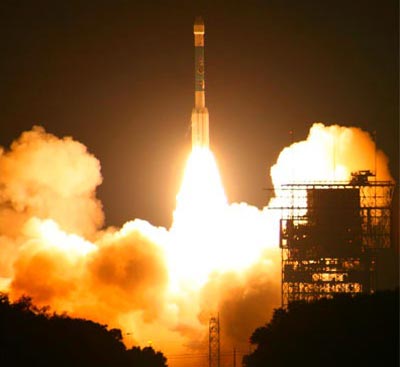Rockets can damage the ozone layer
Smoke escaping in rocket launchers can erode the ozone layer, enabling harmful ultraviolet rays from the sun to penetrate the earth.

The rocket emits chlorine gas on the stratosphere.Here chlorine reacts with oxygen and produces chlorine oxide, a substance that destroys ozone.Photo: nasaimages.org.
Thanks to international laws that ozone-harmful chemicals such as chlorofluorocarbon (CFC), methyl bromide are decreasing. But when launching solid fuel missiles, they discharged chlorine gas directly into the stratosphere (about 50 km from the earth's surface). Here chlorine reacts with oxygen to produce chlorine oxide - a substance capable of destroying ozone.
In the midst of increasing satellite launches, spacecraft around the world, missiles will soon become the most frightening threat to the ozone layer. 'The situation is not urgent, but if we wait another 30 years, everything will be different,' said Darin Toohey, a University of Colorado scientist.
Currently the US, the European Union and India use both liquid fuel and solid fuel for their missiles. This mixture exists in powder or crystal form. Russia and China alone only use liquid fuel. Many scientists believe that rocket fuel has a lower level of damage to the ozone layer than solid fuel.
'Future missiles will use liquid fuel and they will fly to the sky 10 to 100 times more than today's missiles. With such a high frequency, I guess the ozone layer will be negatively affected within 10 to 20 years. However, we have no evidence to prove this claim, ' said Martin Ross, an atmospheric researcher at Aerospace Group in Los Angeles (USA).
Each type of fuel in rockets has different levels of pollution. Some fuels release chemicals into the lower atmosphere. Here they quickly disappear thanks to the rain. Some other chemicals discharge chemicals in the stratosphere, where they last longer and react with other chemicals.
From 1979 to 1990 the amount of ozone in the stratosphere decreased by about 5%. Because the ozone layer prevents most of the sun's harmful ultraviolet rays, its decline becomes a global concern. The countries signed the Montreal Protocol to limit and completely stop the use and production of carbon compounds of chlorine and fluorine as well as other ozone-depleting chemicals.
Ozone depletion varies according to geography and depending on the season. The ozone hole refers to a temporary ozone depletion every year at the two poles of the earth. The high concentration of chlorine in the stratosphere (chlorine that appears CFC and other gases produced by humans decomposes) is the cause of the decline of this Earth's armor plate.
- The Earth's ozone layer is being filled again
- Protect the ozone layer connecting the world
- What is the ozone layer?
- New discovery of the ozone layer gap in Antarctica
- Still need to be alert for ozone layer hole
- The hole in the Antarctic ozone layer is shrinking
- Is harmful ozone inhaled harmful?
- The ozone layer only recovered after 40 years
- The ozone hole can be healed in 2070
- Discover the mysterious existence of ozone-killing 'environment'
- The person who discovered the ozone layer hole died
- The ozone layer is recovering after years of recession
 Is the magnetic North Pole shift dangerous to humanity?
Is the magnetic North Pole shift dangerous to humanity? Washington legalizes the recycling of human bodies into fertilizer
Washington legalizes the recycling of human bodies into fertilizer Lightning stone - the mysterious guest
Lightning stone - the mysterious guest Stunned by the mysterious sunset, strange appearance
Stunned by the mysterious sunset, strange appearance